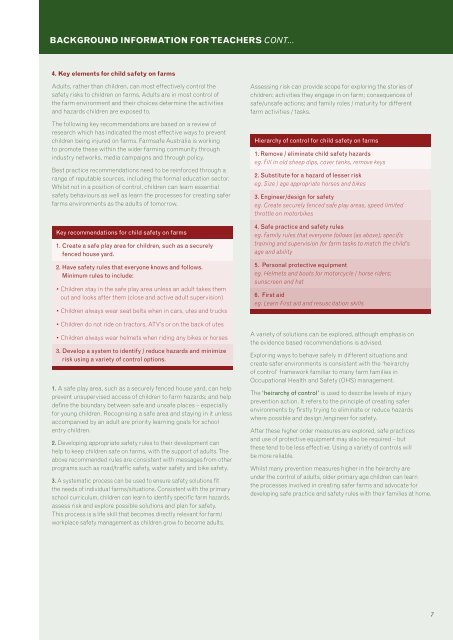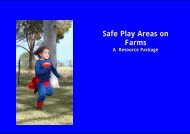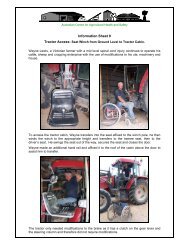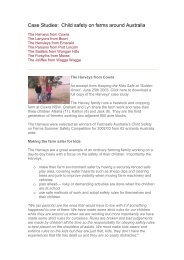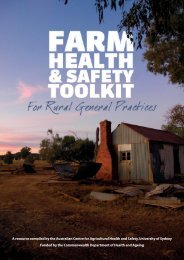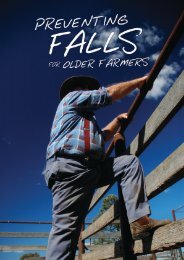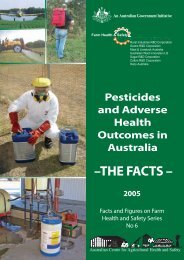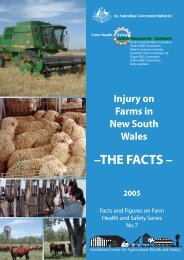Ripper ii Educational resource for primary schools - Australian ...
Ripper ii Educational resource for primary schools - Australian ...
Ripper ii Educational resource for primary schools - Australian ...
Create successful ePaper yourself
Turn your PDF publications into a flip-book with our unique Google optimized e-Paper software.
BACKGROUND INFORMATION FOR TEACHERS CONT...4. Key elements <strong>for</strong> child safety on farmsAdults, rather than children, can most effectively control thesafety risks to children on farms. Adults are in most control ofthe farm environment and their choices determine the activitiesand hazards children are exposed to.The following key recommendations are based on a review ofresearch which has indicated the most effective ways to preventchildren being injured on farms. Farmsafe Australia is workingto promote these within the wider farming community throughindustry networks, media campaigns and through policy.Best practice recommendations need to be rein<strong>for</strong>ced through arange of reputable sources, including the <strong>for</strong>mal education sector.Whilst not in a position of control, children can learn essentialsafety behaviours as well as learn the processes <strong>for</strong> creating saferfarms environments as the adults of tomorrow.Key recommendations <strong>for</strong> child safety on farms1. Create a safe play area <strong>for</strong> children, such as a securelyfenced house yard.2. Have safety rules that everyone knows and follows.Minimum rules to include:• Children stay in the safe play area unless an adult takes themout and looks after them (close and active adult supervision)• Children always wear seat belts when in cars, utes and trucks• Children do not ride on tractors, ATV’s or on the back of utes• Children always wear helmets when riding any bikes or horses3. Develop a system to identify / reduce hazards and minimizerisk using a variety of control options.1. A safe play area, such as a securely fenced house yard, can helpprevent unsupervised access of children to farm hazards; and helpdefine the boundary between safe and unsafe places – especially<strong>for</strong> young children. Recognising a safe area and staying in it unlessaccompanied by an adult are priority learning goals <strong>for</strong> schoolentry children.2. Developing appropriate safety rules to their development canhelp to keep children safe on farms, with the support of adults. Theabove recommended rules are consistent with messages from otherprograms such as road/traffic safety, water safety and bike safety.3. A systematic process can be used to ensure safety solutions fitthe needs of individual farms/situations. Consistent with the <strong>primary</strong>school curriculum, children can learn to identify specific farm hazards,assess risk and explore possible solutions and plan <strong>for</strong> safety.This process is a life skill that becomes directly relevant <strong>for</strong> farm/workplace safety management as children grow to become adults.Assessing risk can provide scope <strong>for</strong> exploring the stories ofchildren; activities they engage in on farm; consequences ofsafe/unsafe actions; and family roles / maturity <strong>for</strong> differentfarm activities / tasks.Hierarchy of control <strong>for</strong> child safety on farms1. Remove / eliminate child safety hazardseg. Fill in old sheep dips, cover tanks, remove keys2. Substitute <strong>for</strong> a hazard of lesser riskeg. Size / age appropriate horses and bikes3. Engineer/design <strong>for</strong> safetyeg. Create securely fenced safe play areas, speed limitedthrottle on motorbikes4. Safe practice and safety ruleseg. Family rules that everyone follows (as above); specifictraining and supervision <strong>for</strong> farm tasks to match the child’sage and ability5. Personal protective equipmenteg. Helmets and boots <strong>for</strong> motorcycle / horse riders;sunscreen and hat6. First aideg. Learn First aid and resuscitation skillsA variety of solutions can be explored, although emphasis onthe evidence based recommendations is advised.Exploring ways to behave safely in different situations andcreate safer environments is consistent with the ‘heirarchyof control’ framework familiar to many farm families inOccupational Health and Safety (OHS) management.The ‘heirarchy of control’ is used to describe levels of injuryprevention action. It refers to the principle of creating saferenvironments by firstly trying to eliminate or reduce hazardswhere possible and design /engineer <strong>for</strong> safety.After these higher order measures are explored, safe practicesand use of protective equipment may also be required – butthese tend to be less effective. Using a variety of controls willbe more reliable.Whilst many prevention measures higher in the heirarchy areunder the control of adults, older <strong>primary</strong> age children can learnthe processes involved in creating safer farms and advocate <strong>for</strong>developing safe practice and safety rules with their families at home.7


